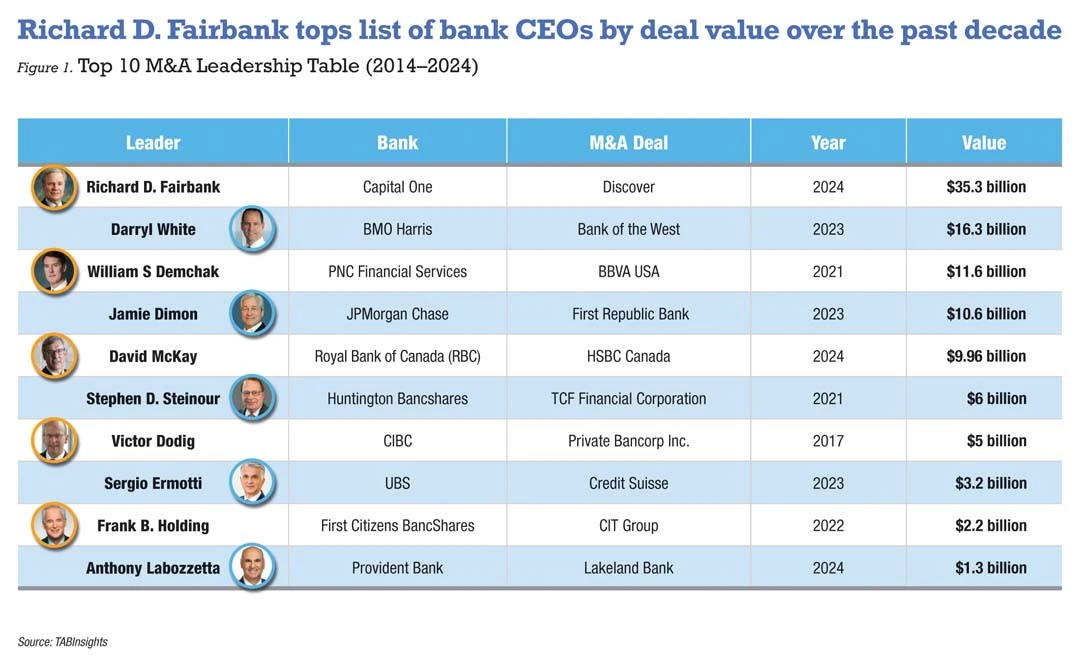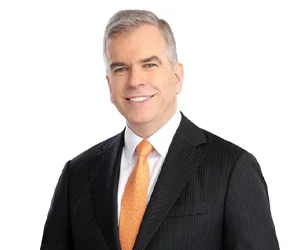The last decade has witnessed a wave of large-scale mergers & acquisitions (M&A) in banking, driven by expansion, consolidation and crisis management. According to TAB Global’s M&A Leadership analysis, the top 10 transactions led by current bank chief executive officers (CEOs) reflect how modern banking leadership aligns opportunity with strategy. These deals go beyond balance sheet growth; they redefine business models and competitive positioning in an ever-evolving financial landscape.
The ranking covers the period from 2014 and 2024, spotlighting current CEOs who personally oversaw major transactions during their tenure. It is ordered by deal value, emphasising leadership accountability and continuing strategic influence. Banks whose landmark deals were completed under former executives are excluded. The results heavily favour North American and European institutions, where transparent valuations and larger deal sizes dominate the global M&A scene.
North American bank CEOs reshape global banking through M&A
North American banks are not only the largest by deal size, but their leadership has also set new benchmarks for strategic impact in the global financial system. Richard D. Fairbank, chairman and CEO of Capital One, leads the charge with the $35.3 billion acquisition of Discover Financial Services in 2024, one of the largest US banking deals in recent years. This move firmly positions Capital One to compete directly with Visa and Mastercard by merging a closed-loop payments network with its already vast credit card portfolio. Fairbank’s bold vision pushes the boundaries of the US payments ecosystem, showing how targeted M&A can redefine industry power dynamics.

Similarly, Darryl White of Bank of Montreal (BMO) spearheaded the $16.3 billion acquisition of Bank of the West in 2023, dramatically expanding BMO’s footprint in the US and diversifying its revenue streams outside the Canadian market. The move, under White’s leadership, exemplifies how international banks can leverage strategic acquisitions to gain global scale while managing risk.
William S. Demchak of PNC Financial Services transformed his bank’s reach with the $11.6 billion acquisition of BBVA USA in 2021. The deal turned PNC into a coast-to-coast US powerhouse, giving it critical mass across retail and commercial banking nationwide and enabling greater portfolio diversification.
Jamie Dimon, CEO of JPMorgan Chase, has built a legacy of bold M&A moves to navigate crisis environments. His $10.6 billion acquisition of First Republic Bank in 2023 amid the regional banking collapse cemented JPMorgan’s position as the industry’s stabiliser, expanding its wealth management franchise. Dimon’s track record, from Bear Stearns to First Republic, highlights his ability to turn systemic turmoil into opportunity, proving that in the right hands, leadership under pressure can shape the future of banking.
Other North American leaders have also embraced strategic scaling. David McKay of Royal Bank of Canada (RBC) solidified his bank’s dominance in Canada with the $9.96 billion purchase of HSBC Canada in 2024, a deal that expanded RBC’s international client base. Meanwhile, Stephen D. Steinour of Huntington Bancshares made a strategic move in the Midwest with the $6 billion merger with TCF Financial Corporation in 2021, adding 450 branches and significantly boosting its regional presence. These acquisitions reflect a trend of disciplined growth and sound strategic decisions, pushing North American banks to the forefront of global consolidation.
As demonstrated in the Top 10 M&A Leadership Table, North American institutions dominate the global stage, driven not just by capital strength, but by a strategic vision that continues to reshape global banking. The region’s dynamic market environment and robust regulatory framework provide fertile ground for large-scale consolidation that fuels growth and sets new industry standards.
CEOs leverage strategic deals to future-proof their institutions
In Europe, the defining M&A of the decade came not from ambition but out of sheer necessity. Under Sergio Ermotti, UBS orchestrated a government-brokered $3.2 billion rescue of Credit Suisse in 2023, a move that not only staved off systemic contagion but also stabilised the Swiss financial system. Ermotti’s crisis-tested leadership was on full display as he deftly balanced state intervention, market confidence and the expectations of global stakeholders in a scenario of unprecedented complexity.
In parallel, smaller yet highly strategic deals have quietly shaped regional dynamics across the US and Europe. Frank B. Holding, CEO of First Citizens BancShares, led the $2.2 billion acquisition of CIT Group in 2022, expanding into middle-market lending and equipment finance. This move helped First Citizens strengthen its position in the competitive landscape, particularly within the rapidly evolving lending markets. Meanwhile, Anthony Labozzetta’s 2024 purchase of Lakeland Bank for $1.3 billion almost doubled Provident Bank’s asset base, expanding its footprint across key Northeastern states, including New Jersey, New York and Pennsylvania.
These transactions underscore a fundamental shift in the purpose of M&A. What was once driven by opportunistic growth is increasingly seen as a tool for long-term structural realignment. Leaders are now focused not just on increasing size, but on strengthening operational resilience, seamlessly integrating technology and positioning their institutions to better navigate future regulatory and digital challenges. In this new environment, strategic execution, more than deal size alone, has become the hallmark of leadership success in M&A.
Bank leaders can learn M&A discipline from North American peers
The dominance of North American banks in global M&A reflects not just market scale but the leadership conditions that make bold moves possible. North American CEOs benefit from regulatory systems that encourage efficiency, capital markets that reward consolidation and governance structures that align shareholders behind long-term strategy. This clarity allows leaders to act decisively, turning mergers into instruments of growth rather than defensive measures.
Leaders in Asia, the Middle East and Africa operate within more complex realities. Regulation tends to be cautious, ownership structures concentrated and market transparency uneven. These constraints make large-scale consolidation difficult and risk appetite lower. Yet, they also create room for different forms of leadership — adaptive, innovative and locally attuned.
Still, there are lessons to take from North America’s M&A playbook. Strong governance and clear communication with investors and regulators give CEOs the confidence to pursue strategic combinations. A disciplined focus on integration — both cultural and operational — helps sustain value after deals close. Above all, North American leaders view M&A as part of a broader strategy for competitiveness, not an end in itself.
Several Asian banks are already applying these lessons in their own way. DBS Bank (Singapore), Mitsubishi UFJ Financial Group (MUFG, Japan) and Industrial and Commercial Bank of China (ICBC, China) have used targeted acquisitions to deepen regional networks and strengthen digital capability. Their leaders have shown that M&A can complement, but not replace innovation, when guided by a clear vision and the capacity to integrate effectively.
For emerging-market banks, the path forward lies in combining North America’s decisiveness with their own strategic agility. Transparent governance, aligned capital and credible integration planning will determine who can turn opportunity into sustainable growth. Ultimately, leadership is not defined by the size of the deal but by the clarity of the decision.
































